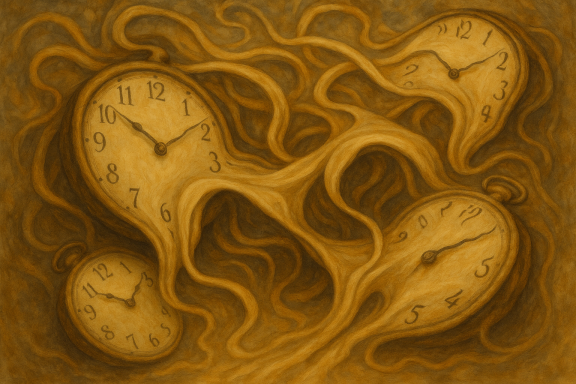Keigo Higashino, one of Japan’s most celebrated mystery writers, is renowned for his intricate plots and deep psychological insight. His stories go beyond identifying the culprit — they delve into why a crime was committed and what lies beneath the surface of human behavior. One of the most compelling features of Higashino’s work is his frequent use of temporal paradoxes and his philosophical inquiry into the nature of time. In this article, we’ll explore how Higashino manipulates time and paradox to challenge the reader’s moral perspective and perception of truth.
1. Is Time a Straight Line?
In The Devotion of Suspect X, one of Higashino’s most acclaimed novels, time becomes both a tool for concealment and a key to uncovering truth. The structure of the alibi, the moment the crime was committed, and the decisions made by the characters all play with the perception of chronological reality.
Higashino presents time not as a linear, objective flow, but as an organic construct that can be bent and reframed by human emotion and decision-making. This portrayal invites readers to reconsider whether time is truly constant — or if it’s something that morphs depending on how we experience it.
2. Paradox: The Thin Line Between Truth and Lies
Paradoxes are a recurring theme in Higashino’s works. A paradox, by definition, contains contradictory elements that may nonetheless be true. In his stories, we often see situations where the villain acts out of love, or where someone falsely confesses to protect another. These moral contradictions, seen in novels like Byakuyakō (Journey Under the Midnight Sun) and The Miracles of the Namiya General Store, force readers to grapple with the blurred line between right and wrong.
Such narrative devices don’t just add intrigue — they challenge the reader’s ethical framework and make them question absolute definitions of justice, love, and guilt.
3. Time Travel and the Loops of Fate
Higashino sometimes steps into the realm of science fiction to probe the deeper implications of time. In Laplace’s Witch, time is explored through scientific determinism and the ability to predict future events. This raises questions about whether the future is predetermined or shaped by free will.
In contrast, The Wings of the Kirin connects past actions with present morality, illustrating how time links people and decisions across generations. These works suggest that time is not simply something we move through — it is something we shape, and in turn, are shaped by.
4. Memory and Temporal Distortion
In Mōhan-ka (Phantom Flower) and Letters, Higashino explores how memory distorts time. A character’s recollection of the past often turns out to be unreliable, leading to present-day consequences based on flawed perception. These narratives illustrate that time is not just physical but psychological, intimately tied to regret, forgiveness, and emotional healing.
Higashino uses this distortion to highlight how the past lingers in the present — not as fixed fact, but as shifting memory, deeply colored by emotion and perspective.
5. Why Higashino’s Time Feels Unique
In Higashino’s novels, time is never just a backdrop for storytelling. It’s an active, shaping force — a philosophical thread woven through every character and decision. He values the process by which truth is uncovered more than the truth itself, and time plays a central role in that process.
His characters are often trapped in the past, attempting to rewrite the future, or unable to fully face the present. Through them, readers are invited to reflect on their own relationship with time — how we hold on to it, how it slips away, and how it can be both prison and path to redemption.
Higashino’s works offer far more than crime-solving puzzles. They are rich, philosophical narratives that explore the human condition through the lens of time and paradox. As we read, we’re not just looking for culprits — we’re searching for answers to the deeper questions of memory, morality, and the irreversibility of time.
